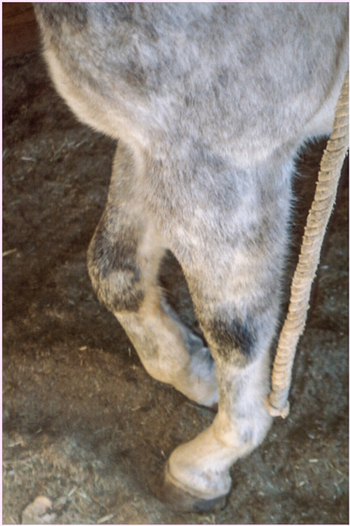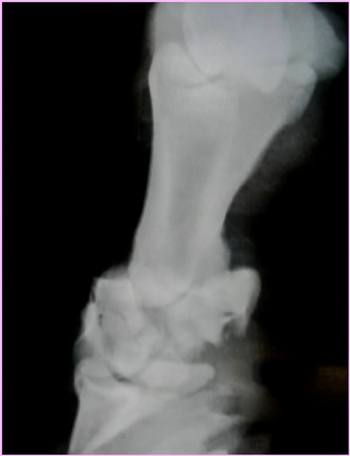Treating a Horse’s Broken Leg


Horses love to run, plain and simple. And, we ask them to do athletic exercises that put maximal load on their limbs. Long bone fractures typically occur with a misstep or trauma due to impact from a kick, collision, or fall. A horse that sprints too fast across a broken field or plays exuberantly on a longe line may shatter a pastern. Stepping in a hole may break a cannon bone. A horse that is kicked or catches a leg in a gate may suffer a broken leg.
How to Tell if Your Horse Has a Broken Leg
For starters, a horse with a broken leg will refuse to put the leg on the ground, even the lightest touch. He will stand firmly in one place, not wanting to move, and if forced to move, he’ll hop while holding the fractured limb in the air. (Other non-fracture situations—foot abscess, torn ligament or tendon, or joint infection—also can cause a horse to be non-weight-bearing due to extreme pain.)
A hairline crack in a bone may produce lameness, but not enough to cause the horse to be super protective of the limb. With continued exercise, or even as a horse gets up or lies down, a small crack could turn into a full-blown fracture. A chip fracture within a joint tends to be more stable and less urgent but still can lead to performance-limiting consequences if not addressed.
The limb with a serious fracture may appear to hang in an abnormal position or alignment, or with a compound fracture, you may see bone poking through the skin. The area around a fracture usually swells immediately.
Diagnosis, Stabilization, and Treatment Options


To confirm that a horse has suffered a fracture, you need your veterinarian to examine the horse as soon as possible. Field radiographs (x-rays) are taken to identify the degree and extent of the fracture to determine if surgical repair is possible. Your veterinarian might put hands on gently to determine the degree of instability of the injury by feeling for crepitus (grating) from bone fragments moving around. Under no circumstances should you attempt this as that creates more soft tissue damage, pain and contamination. In some cases, the nature or location of the fracture, the expense of repair, or an uncooperative temperament of the horse may preclude the ability to repair a broken leg.
Hairline fractures may not show up on radiographic exam for a few weeks until some bone mineral resorbs around the crack. A nuclear bone scan (scintigraphy) may help to diagnose a thin crack.
Before the horse is moved, the leg needs to be padded and splinted to prevent any movement around the fractured area. The general rule is to immobilize the joint above and below a fracture site – if the cannon bone is broken, then a splint encompasses the fetlock all the way up above the knee. Splints can be made from 2×4 lumber or PVC pipe cut lengthwise in half. Padding is available using roll cotton, leg quilts, pillows, or blankets. A make-shift splint can be secured using Gorilla tape.
Once the horse is stabilized and the limb immobilized, it is necessary to get the horse to an equine hospital for surgical repair. Travel in a trailer is difficult, but it helps if the horse has a partition to lean against and you drive slowly and carefully.
Treatment for fractures can vary, and of course will be determined by the owner’s budget, the intended use for the horse, and other factors. Some fractures need internal fixation with screws and metal plates; others are repaired with external fixation using pins, wires and plates on the outside of the leg that are affixed through the skin to the bone. Others require casting. The horse with a fracture repair needs strict confinement for 12-16 weeks to allow healing. Make plans on how to safely confine the horse to achieve the best outcome.
While a broken leg of a horse may have been impossible to treat a long time ago, treatment options have progressed significantly. Some fractures are easier to treat, may not even need surgery, and can have a very good prognosis. Always consult with your veterinarian to understand the options available to help your horse.
What to Do for a Horse with a Possible Fracture Until Your Vet Arrives◆ When you discover your horse is injured, call your vet immediately to come out. |
Recent Posts
The Working Mules of our Public Lands
Flopping ears bounce with every step down the trail as a string of six mules begin the trek from the…
Sabrina Lewis and Her Crowning Achievements
Speaking on a stage surrounded by the glitz and glamour of the Miss America Pageant, Sabrina Lewis stands out with…
Equine Insurance Policies
Insurance. It’s a fact of life for most adults. We insure our vehicles, homes, businesses—even our smartphones. We buy life…
2025 Defender Kentucky Three-Day Event
Stay up to date on the action from the 2025 Defender Kentucky Three-Day Event. Find information about the event, including…
Cosequin® Lexington 4*-S at Defender Kentucky Three-Day Event presented by MARS Equestrian™ to Serve as US Equestrian Open Eventing Series Qualifier
Lexington, Ky. — This year’s Cosequin® Lexington 4*-S will serve as a US Equestrian Open Eventing Series Qualifier when the…
Ten Magical Days in Ocala: From Live Oak International to Longines League of Nations & More Horsey Adventures
Much like the cream center of an Oreo cookie, there is a sweet spot in the middle of Ocala winter…
View Comments
keeping a horse immobilized for 8-12 weeks is barbaric
What are your credentials? You have presented none. You have only presented your opinion. Everyone has one of those.
Andrew its not its what you have to do for the horse